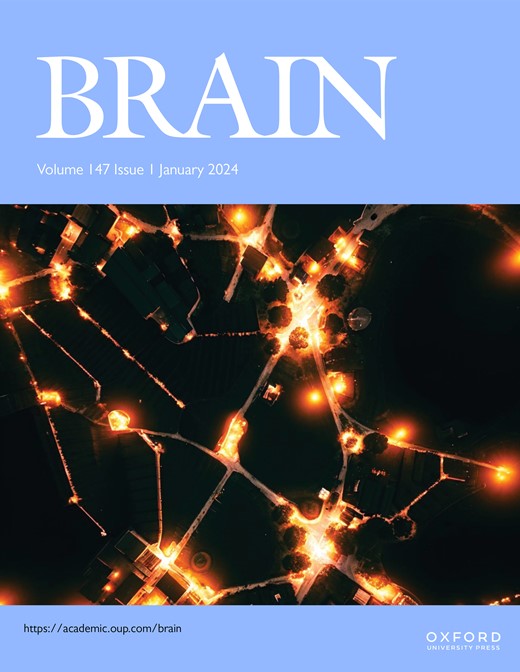Stimulants for disorders of consciousness in the intensive care unit: a randomized, placebo-controlled trial
IF 10.6
1区 医学
Q1 CLINICAL NEUROLOGY
引用次数: 0
Abstract
In the intensive care unit (ICU), management of unresponsive patients with brain injury focuses on preventing secondary brain damage. Therapeutic strategies that directly promote the recovery of consciousness are urgently needed. In an investigator-initiated, randomized, placebo-controlled, double-blind, cross-over trial, we studied the effects of apomorphine and methylphenidate in ICU patients with acute disorders of consciousness (DoC). We hypothesized that these stimulants would improve consciousness biomarkers assessed by automated pupillometry (primary outcome) and clinical signs of consciousness (secondary outcome). We randomized 50 ICU patients with DoC (14 women; mean age 63 ± 10 years; 48 with non-traumatic brain injuries) to strata consisting of three consecutive treatment sessions during which apomorphine, methylphenidate or placebo were administered. In total, we administered 112 study medications, including 36 doses of apomorphine, 39 doses of methylphenidate and 37 doses of placebo. Missing administrations were due to death, ICU discharge, or spontaneous consciousness recovery. Plasma concentrations of stimulants confirmed drug exposure. We found no adverse events related to the trial drugs. Pupillometry recordings of sufficient quality (n = 590) were available from 48 (96%) patients. A pupillary response to a verbal arithmetic command (i.e., ≥3 pupillary dilations on five verbal arithmetic tasks) was identified during 70 (12%) of these recordings. Seven (15%) patients without any other observable response to spoken commands also passed a stricter threshold of ≥4 pupillary dilations, suggesting cognitive motor dissociation. Apomorphine (OR 1.35, 95% CI: 0.93 to 1.96) and methylphenidate (OR 1.29, 95% CI: 0.89 to 1.86) did not significantly increase pupillary responses. However, after study drug administration, 10 (20%) patients showed improved clinical arousal at least once. Signs of arousal were noted after one dose of placebo, four doses of apomorphine (OR 5.04, 95% CI: 0.56 to 120.7), and seven doses of methylphenidate (OR 9.96, 95% CI: 1.36 to 235.8). Changes toward higher consciousness level categories were observed once after placebo, four times after apomorphine (OR 5.67, 95% CI 0.63 to 169.46), and three times after methylphenidate (OR 3.41, 95% CI 0.34 to 88.00). In a post-hoc analysis, patients with greater pupillary responsiveness showed better arousal, suggesting that this condition may predict stimulant drug effects. In conclusion, while pupillometry revealed no direct drug effects on overall pupillary responses, stimulants may have triggered clinical arousal in some patients, particularly in those with greater pupillary responsiveness. These findings require replication but should guide future pharmacological trials aimed at improving consciousness recovery after brain injury.重症监护病房意识障碍的兴奋剂:一项随机安慰剂对照试验
在重症监护室(ICU),管理无反应的脑损伤患者的重点是防止继发性脑损伤。迫切需要直接促进意识恢复的治疗策略。在一项研究者发起、随机、安慰剂对照、双盲、交叉试验中,我们研究了阿波啡和哌甲酯对ICU急性意识障碍(DoC)患者的影响。我们假设这些兴奋剂可以改善通过自动瞳孔测量法评估的意识生物标志物(主要结果)和临床意识体征(次要结果)。我们随机选择了50例ICU患者(14名女性;平均年龄63±10岁;48例非创伤性脑损伤患者)分为三个连续治疗阶段,在此期间给予阿普吗啡,哌醋甲酯或安慰剂。我们总共使用了112种研究药物,包括36剂阿波啡,39剂哌甲酯和37剂安慰剂。缺勤是由于死亡、ICU出院或自发意识恢复。血浆兴奋剂浓度证实了药物暴露。我们没有发现与试验药物相关的不良事件。48例(96%)患者有足够质量的瞳孔测量记录(n = 590)。在70次(12%)的记录中发现了对口头算术命令的瞳孔反应(即在5项口头算术任务中瞳孔扩张≥3次)。7名(15%)患者对口头命令没有任何其他可观察到的反应,也通过了更严格的瞳孔扩张≥4的阈值,提示认知运动分离。阿波啡(OR 1.35, 95% CI: 0.93至1.96)和哌醋甲酯(OR 1.29, 95% CI: 0.89至1.86)没有显著增加瞳孔反应。然而,在服用研究药物后,10例(20%)患者表现出至少一次临床觉醒改善。在服用1剂安慰剂、4剂阿波啡(OR 5.04, 95% CI: 0.56至120.7)和7剂哌甲酯(OR 9.96, 95% CI: 1.36至235.8)后发现觉醒迹象。安慰剂组观察到一次向更高意识水平类别的改变,阿波吗啡组观察到4次(OR 5.67, 95% CI 0.63至169.46),哌醋甲酯组观察到3次(OR 3.41, 95% CI 0.34至88.00)。在事后分析中,瞳孔反应性更强的患者表现出更好的觉醒,这表明这种情况可能预示着兴奋剂药物的作用。总之,虽然瞳孔测量显示药物对整体瞳孔反应没有直接影响,但兴奋剂可能会在一些患者中引发临床觉醒,特别是那些瞳孔反应性较强的患者。这些发现需要复制,但应该指导未来旨在改善脑损伤后意识恢复的药理学试验。
本文章由计算机程序翻译,如有差异,请以英文原文为准。
求助全文
约1分钟内获得全文
求助全文
来源期刊

Brain
医学-临床神经学
CiteScore
20.30
自引率
4.10%
发文量
458
审稿时长
3-6 weeks
期刊介绍:
Brain, a journal focused on clinical neurology and translational neuroscience, has been publishing landmark papers since 1878. The journal aims to expand its scope by including studies that shed light on disease mechanisms and conducting innovative clinical trials for brain disorders. With a wide range of topics covered, the Editorial Board represents the international readership and diverse coverage of the journal. Accepted articles are promptly posted online, typically within a few weeks of acceptance. As of 2022, Brain holds an impressive impact factor of 14.5, according to the Journal Citation Reports.
 求助内容:
求助内容: 应助结果提醒方式:
应助结果提醒方式:


